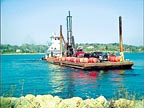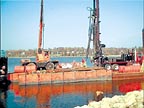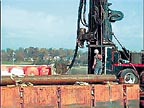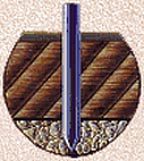
EFD proposed to set up its Barber DR 24 rig on a series of barges that could be adjusted to obtain an opening for advancement of the drill stem. A Barber DR drill has two separate rotary drives. There is an outward pivoting tophead that has the ability to turn standard drill pipe, as well as dual tube applications. The lower drive is a large hydraulic ring gear that clamps onto steel casing. The lower drive cannot only spin the casing in the ground, it also advances the casing using down pressure. Drill rods and steel casings are loaded from the rear using the outside pivoting tophead, along with the assistance of a winch or crane behind the rig.




Contractor Profile
Environmental & Foundation Drilling Inc.217 Raemisch Road
Waunakee, Wis. 53597
608-849-9896
www.efdrilling.com
Through the leadership of co-owners Matthew Hood and Gregory Anderson, Environmental and Foundation Drilling Inc. has been growing and serving the needs of engineering and construction professionals for over 14 years. The firm has performed over 4,500 projects for hundreds of different engineering, construction and public sector agencies. The projects have included 5-foot auger holes for pavement design parameters to 1,300-foot high capacity water wells. EFD has worked on many industrial sites and superfund jobs that required the coordination of many rigs.
The company's modern line of CME auger drill rigs are capable of drilling with hollow-stem augers from 2.25 inches to 12.25 inches, as well as a variety of mud drilling, rock coring and air rotary methods. The drilling platforms are mounted upon trailers, single- and tandem-axle trucks, or all-terrain carriers that are capable of off-road uses. Environmental & Foundation Drilling also is equipped with a full line of drilling tools and support vehicles, including heavy-duty 4-by-4 pickups, flatbed water trucks and self-designed mobile decontamination trailers.
Complementing the auger rigs are two Barber dual rotary drill rigs and a Gus Pech Super 48 bucket auger rig. The Barber has the ability to advance casing and standard drill pipe simultaneously, as well as dual tube drilling applications. Bedrock, heaving sands and cobbles are drilled and cased efficiently, making deep holes installed in difficult drilling mediums cost effective and realistically obtainable. This machine is capable of installing prebored piles, elevator shafts, discreet water sampling dual tube borings and large diameter recovery wells. The bucket rig has many construction-related abilities, including holes for caissons and landfill vent wells.
All drillers and technicians employed by EFD have completed the OSHA-required 40-hour health and safety training course, as well as yearly eight-hour in-house refresher courses. Furthermore, all employees are first aid and CPR certified. In addition to their classroom training, employees are medically monitored with yearly comprehensive exams.

Report Abusive Comment